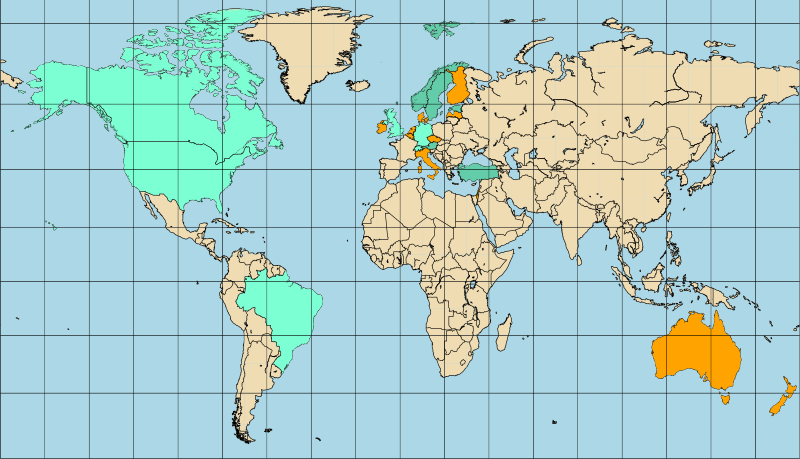On the Status Quo of General Relativity in School Curricula
Ute Kraus and Corvin Zahn
With contributions by Lisa Büssing, Stuart Farmer, Lorenzo Galante, Fadeel Joubran, Magdalena Kersting, Gerd Kortemeyer, Richard Meagher, Alina Neumann, Joao Pereira.
I) Overview
Is general relativity mentioned in the curriculum of this country?
Country |
yes |
no |
remarks |
Data as at |
Australia |
|
x |
|
08/2020 |
Austria |
x |
|
|
08/2020 |
Belgium |
|
x |
Flanders: no, other regions? |
09/2017 |
Brazil |
x |
|
Rio de Janeiro: yes, other regions? |
07/2017 |
Canada |
x |
|
Ontario: yes, other provinces: no |
08/2020 |
Czech Republic |
|
x |
|
09/2017 |
Denmark |
|
x |
|
08/2020 |
Estonia |
x |
|
|
08/2020 |
Finland |
|
x |
|
07/2017 |
Germany |
x |
|
4 out of 16 states: yes, others: no |
08/2020 |
Hongkong |
|
x |
|
08/2020 |
Ireland |
|
x |
|
08/2020 |
Italy |
|
x |
|
02/2019 |
Israel |
|
x |
|
02/2019 |
Latvia |
|
x |
|
08/2020 |
Luxembourg |
|
x |
|
08/2020 |
Malta |
|
x |
|
08/2020 |
Netherlands |
|
x |
|
08/2020 |
New Zealand |
|
x |
|
08/2020 |
Norway |
x |
|
|
07/2017 |
Singapore |
|
x |
|
08/2020 |
Sweden |
x |
|
|
08/2020 |
Switzerland |
x |
|
in some cantons, in some schools |
2018 |
Turkey |
x |
|
|
09/2017 |
UK |
x |
|
Scotland: yes, England, Wales: no |
08/2020 |
USA |
x |
|
federal curriculum: no, some school curricula: yes |
2017 |
GR in the curriculum: dark green - yes, light green - partly, orange - no

II) Content
country |
curriculum on GR |
remarks |
Data as at |
Austria |
National curriculum: basic concepts of general relativity. From implementation by different teachers: equivalence principle, clocks and rulers in a gravitational field, curvature of space, gravitational lenses, gravitational waves and LIGO, black holes, effect on GPS, non-Euclidean geometry |
|
08/2020 |
Brazil (Rio de Janeiro) |
Recognize the present models of the universe (stellar evolution, black holes, curved space and big bang) |
Ensino Medio, age 15 |
07/2017 |
Estonia |
Equivalence principle, gravitational interaction described through bending space-time, cosmology |
required / optional subject |
08/2020 |
Canada (Ontario) |
Theory of general relativity |
age 17-18 |
08/2020 |
Germany (Bremen) |
Equivalence principle, experimental tests (precession of the perihelion of Mercury, light deflection near the sun, gravitational redshift) |
advanced level, ages 16-17 |
12/2017 |
Germany (North Rhine-Westfalia) |
Basic statements of GR: gravitational time dilation, equivalence principle, gravitation and time measurement (describe qualitatively); gravitation, time measurement and curvature of space (illustrate using models and graphics); impact on physical world view |
advanced level, ages 16-17 |
12/2017 |
Germany (Saarland) |
Reference to GR as theory of gravitation and to its significance for astrophysics and cosmology |
age 16 |
12/2017 |
Germany (Saxony) |
Evidence for the impact of gravitation on light: reference to GR, gravitation and curved spacetime, experiments with atomic clocks, black holes in the universe |
standard level, age 16 |
12/2017 |
|
Selected aspects of GR: gravitation and curved spacetime, experiments with atomic clocks, black holes in the universe, big bang theory |
advanced level, age 16 |
12/2017 |
Norway |
… give a qualitative description of general relativity |
upper secondary school |
07/2017 |
Sweden |
… an introduction to the general theory of relativity |
|
08/2017 |
Switzerland |
Basic principles of general relativity. // Basic principles of general relativity, experimental tests. // The students know ideas and basic concepts of general relativity in a qualitative way. // The students are given a short, qualitative insight into general relativity. // The students can explain the concept of spatial curvature using a simple example. // The students can state the limited field of application of special relativity and fundamental principles of general relativity using a simple example. |
From individual cantonal and school curricula |
2018 |
Turkey |
Big Bang, Cosmological models |
|
09/2017 |
UK (Scotland) |
Knowledge that special relativity deals with motion in inertial (non-accelerating) frames of reference and that general relativity deals with motion in non-inertial (accelerating) frames of reference. --- Statement of the equivalence principle (that it is not possible to distinguish between the effects on an observer of a uniform gravitational field and of a constant acceleration) and awareness of its consequences. --- Consideration of spacetime as a representation of four dimensional space. --- Knowledge that light or a freely moving object follows a geodesic (the shortest distance between two points) in spacetime. --- Knowledge that GR leads to the interpretation that mass curves spacetime, and that gravity arises from the curvature of spacetime. --- Representation of World lines for objects which are stationary, moving with constant velocity and accelerating. --- Use of an appropriate relationship to solve problems relating to the Schwarzschild radius of a black hole. --- Knowledge that time appears to be frozen at the event horizon of a black hole. |
Advanced Higher Physics, ages 17-18 |
02/2019 |